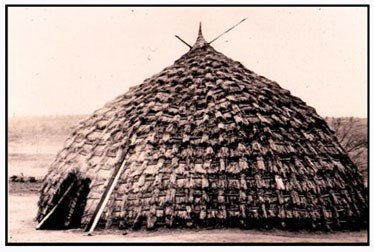
Kansas State Historical Society Human activity in the Kansas Flint Hills can be traced back about 12,000 years. Humans used the area's natural resources by hunting large mammals and gathering wild plants. Exchange networks extended well beyond the Plains (ca 6,000 B.C.-A.D.1). Beginning about A.D.1, new subsistence and technological traits developed, including the routine production of ceramics, the use of domesticated plants, and hunting with bow and arrow. From about A.D.1000, domesticated plants and associated artifacts reflect a predominantly horticultural existence shifting to settled village life (Jones 1999: 6-9, 14-17). By A.D.1500 - 1825, efficient horticultural activity was combined with increased bison hunting, almost certainly due to acquisition of the horse by Native Americans. This transition on the Information from the Tallgrass Prairie National Preserve General Management Plan. Local TribesThe native peoples of this area grew crops and lived in semi-permanent homes along streams and creeks. The Flint Hills were a communal hunting ground for the tribes. Besides food for the tribes, the Flint Hills also provided much-needed chert or "flint." They used this stone to make tools, weapons, and ceremonial pieces. The Kansa tribe occupied the mid-Missouri Valley, near the junctures of Missouri River and Kansas River. Forced westward by more powerful tribes, the Kansa relocated along the lower Kansas Valley concentrating their villages between the mouth of the Big Blue River and Stranger Creek. They remained in eastern Kansas during most of the nineteenth century. However, their tenure in the region seemed perpetually in doubt. They were threatened on their eastern borders by successive waves of emigrant tribes and American settlers. Their westward retreat was blocked by the more numerous and nomadic Plains tribes. Ceding their homeland, they sought refuge on a series of shrinking reservations. In 1872 they surrendered their lands in the fertile Neosho Valley. By 1873 most of the Kansa tribe had moved to northern Oklahoma. Information provided by "The Kansa Indians; A History of the Wind People, 1673 - 1873" by William E. Unrau.
|
Last updated: March 16, 2022
